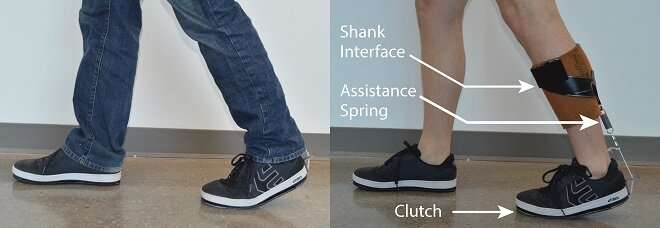While most other exoskeletons or power armors are powered by a system of electric motors or a combination of technologies. One of the biggest problems is its power supply. Besides the battery drainage issue, these are costly and also expensive to repair. Also, they are heavier to carry.
Keeping all these things in mind, the students at Vanderbilt University have engineered a new lightweight, low-profile, and inexpensive ankle exoskeleton. According to the inventors, this is the first ankle plantarflexion assistance exoskeleton that could be feasibly worn under typical daily clothing without restricting ankle motion.
In addition, it doesn’t even require any additional components such as batteries or actuators carried on the back or waist.
A mechanical engineering Ph.D. student and lead author of the study, Matt Yandell, said, “We’ve shown how an unpowered ankle exoskeleton could be redesigned to fit under clothing and inside/under shoes so it more seamlessly integrates into daily life.”
The team invented an unpowered friction clutch mechanism that fits under the foot or shoe and is no thicker than typical shoe insoles. The device weighs just over one pound, including a soft shank sleeve and assistive spring.
Additionally, it costs less than $100 to fabricate without factoring in an optimized design for manufacturing and economies of scale.
“Our design is lightweight, low profile, quiet, uses no motor or batteries, it is low cost to manufacture, and naturally adapts to different walking speeds to assist the ankle muscles,” said Karl Zelik, assistant professor of mechanical engineering and senior author on the study.
The new design highlights the potential for performance-enhancing exoskeletons that are inexpensive, and unobtrusive. It can be used on a wide scale to benefit a broad range of individuals throughout society, such as the elderly, individuals with impaired plantar flexor muscle strength, or recreational users. Also, people with impaired lower-leg muscle strength and workers whose jobs require substantial walking or running.
“It could also help reduce fatigue in occupations that involve lots of walking, such as postal and warehouse workers and soldiers in the field,” Zelik said.
Joshua Tacca, BE’18, also is a co-author. He is now a graduate student in the Integrative Physiology Department at the University of Colorado-Boulder. Several other Vanderbilt undergraduate engineering students also contributed to the device design and pilot testing.
